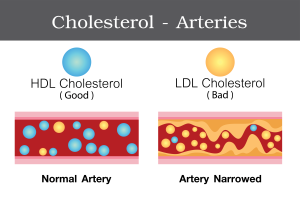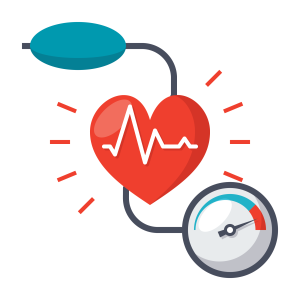Adopt a heart-healthy lifestyle
Cardiovascular disease is the leading cause of death for adults in the United States. Lower your risk by getting your cholesterol and blood pressure checked regularly by your primary care physician, eating heart-healthy foods and exercising.
Carmine D. D’Amico, D.O., a cardiologist at LECOM Health Millcreek Surgical Specialists, explains the warning signs for a potential heart attack as well as preventative measures you can take to live a heart-healthy lifestyle.
What things place you at risk for a heart attack?
- You could have a genetic predisposition to certain things like coronary artery disease or certain valvar disease issues, hypertension or high blood pressure.
- Your family has a history of cardiovascular disease.
- If you have a buildup of plaque in your coronary arteries — which supply the heart muscle with blood — if those block completely, they cause heart attacks.
- You experience symptoms such as angina pectoris, chest discomfort, heaviness or tightness in your chest, usually brought on by physical activity, relieved with rest.
How can you lower your risk of heart disease and live a heart-healthy lifestyle?
 1. Check your cholesterol regularly.
1. Check your cholesterol regularly.
You don’t want to wait until there’s a problem and it’s too late.
- Ask your primary care physician to check your blood for high cholesterol even if you aren’t symptomatic. It’s important to at least get a baseline. Know where you stand because you could have abnormal values and not be symptomatic initially. Have it checked a minimum of every five years until you reach the age of 35 or 40, when it is recommended to have it checked approximately once a year. If your cholesterol is elevated, work with your primary care physician to decide whether or not you should treat it.
- Once you reach the age of 20 or so, have an initial fasting lipid panel done. This lipid panel will let you know your total cholesterol, your triglycerides, your bad cholesterol and your good cholesterol.
 2. Check your blood pressure regularly.
2. Check your blood pressure regularly.
You can use public-access devices to check your blood pressure, but I recommend having it checked by a healthcare professional once or twice a year to make sure you’re getting an accurate blood pressure reading.
3. Eat heart-healthy foods.
Our bodies are intrinsically built to survive to old age. Generally speaking, you can moderate your intake of foods that aren’t extremely heart-healthy and have balance in your diet. In moderation, it’s OK.
Most people can’t stick to a really clean, heart-healthy diet 100% of the time. When you crave certain things, it’s reasonable to give in to those cravings — within limits. Listen to your body. Sometimes it’s nature’s way of getting you the nutrition you need, given the circumstance.
- Eat your veggies, poultry and fish.
- Avoid foods that are high in saturated fat. Generally, those are animal fats/red meats. Instead, opt for poultry or seafood.
- Avoid foods that are high in cholesterol. Keep in mind that it would be difficult to completely eliminate cholesterol or saturated fat from your diet.
- When possible, avoid processed meats. They usually have a high sodium content as well as saturated fat.
- Certain oils, such as olive oil and canola oil, are good for you. Walnuts and almonds are very healthy.
4. Get moving.
Regular exercise is crucial. Of course, not everyone is an athlete. Not everyone really likes to go to the gym. Not everyone likes to go for a jog.
The trick is to find something you can not only tolerate, but maybe even like. Because consistency is key.
You can force yourself to work your way up to jogging 2 to 3 miles per day, but if you hate it, you won’t keep doing it. The same with your diet: If you hate it, you won’t keep doing it.
Tips for selecting a gym:
 The most important factor when considering a gym is convenience for you.
The most important factor when considering a gym is convenience for you.
- Does it have hours that are compatible with your work and family schedule? Some gyms are open late, some very early. Early-morning workouts tend to benefit people who have very hectic schedules. Sometimes the most predictable part of the day is morning, which allows you to get your workout in on a consistent basis. It requires discipline, but you can train yourself to do it, and once you’re used to it, you won’t want to miss it.
- Location, location, location. Geographically, it’s best to find a gym that’s either close to work or close to home; 90% of the battle is getting to the gym on a regular basis. If you have to pass it on your way to work or home, then you don’t have the excuse of it being out of the way.
- The environment of the gym is important, too. Is it safe and clean? You don’t want to go somewhere that makes you feel uncomfortable. And everyone has to start at some point — you shouldn’t feel ashamed if you don’t look or feel like the bodybuilder types. Of course you can exercise in a more private environment, maybe at home, but it’s better to get to a gym because once you get there, everyone is working out and it makes you want to work out; whereas, if you stay at home, you can have too many distractions. If you’re an outdoor person and you like to take walks, dress appropriately. Just pick something you like and definitely don’t hate. Hopefully you’ll find something you like that gets your heartrate up a little bit, and eventually gets you to a good sweat.
Exercise 20 to 30 minutes a day for most days of the week. But even if you can only get 10 minutes here and 10 minutes there, anything is better than nothing. There is a cumulative effect.
Regular exercise has several benefits, including the following:
- Clears your mind
- Contributes to weight loss
- Stabilizes blood pressure
- Helps control blood cholesterol
- Improves attitude
- Acts as an anti-depressant
- Reduces anxiety
Exercise can get you through a lot of tough places in your life.

